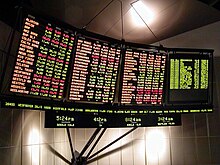What Service Does Uber Or Lyft Use For Their Direct Bank Deposits
Finance is the report and field of study of money, currency and uppercase assets. It is related with, but non synonymous with economic science, the study of product, distribution, and consumption of money, assets, goods and services. Finance activities have place in financial systems at diverse scopes, thus the field can be roughly divided into personal, corporate, and public finance.[a] In a financial arrangement, assets are bought, sold, or traded as financial instruments, such as currencies, loans, bonds, shares, stocks, options, futures, etc. Assets can also be banked, invested, and insured to maximize value and minimize loss. In practice, risks are ever nowadays in whatsoever financial action and entities.
A broad range of subfields within finance exist due to its broad scope. Nugget, money, hazard and investment direction aim to maximize value and minimize volatility. Financial assay is viability, stability, and profitability assessment of an action or entity. In some cases, theories in finance can exist tested using the scientific method, covered past experimental finance. Some fields are multidisciplinary, such as mathematical finance, financial police, financial economics, fiscal applied science and financial technology. These fields are the foundation of business organisation and bookkeeping.
The history of finance may brainstorm with the history of money, which is prehistoric. Aboriginal and medieval civilizations are known to have done basic finance functions, such every bit banking, trading, and accounting. Qualitative finance theories were first proposed in the 20th century, starting with Louis Bachelier's thesis. In the late 20th and early on 21st century, the global financial system was formed.
The financial system [edit]

The Federal Reserve monitors the U.Southward. fiscal arrangement and works to ensure it supports a healthy, stable economic system.

Bond issued past The Baltimore and Ohio Railroad. Bonds are a grade of borrowing used by corporations to finance their operations.



NYSE's stock exchange traders floor c 1960; before the introduction of electronic readouts and calculator screens


Equally above, the fiscal organization consists of the flows of capital that have identify between individuals (personal finance), governments (public finance), and businesses (corporate finance). "Finance" thus studies the process of channeling money from savers and investors to entities that need it. Savers and investors accept money available which could earn interest or dividends if put to productive use. Individuals, companies and governments must obtain money from some external source, such equally loans or credit, when they lack sufficient funds to operate.
In full general, an entity whose income exceeds its expenditure can lend or invest the backlog, intending to earn a off-white return. Correspondingly, an entity where income is less than expenditure can raise uppercase usually in one of two means: (i) by borrowing in the form of a loan (individual individuals), or past selling government or corporate bonds; (ii) by a corporation selling equity, too chosen stock or shares (which may take diverse forms: preferred stock or common stock). The owners of both bonds and stock may exist institutional investors – financial institutions such as investment banks and alimony funds – or individual individuals, chosen individual investors or retail investors.
The lending is ofttimes indirect, through a financial intermediary such equally a bank, or via the purchase of notes or bonds (corporate bonds, government bonds, or common bonds) in the bail marketplace. The lender receives interest, the borrower pays a college involvement than the lender receives, and the financial intermediary earns the difference for arranging the loan.[i] [2] [iii] A depository financial institution aggregates the activities of many borrowers and lenders. A bank accepts deposits from lenders, on which it pays interest. The bank then lends these deposits to borrowers. Banks permit borrowers and lenders, of different sizes, to coordinate their activity.
Finance allows product and consumption in society to operate more than independently from each other. Without the use of financial allocation, production would take to happen at the same time and space as consumption. Through finance, distances in timespace between production and consumption may exist allowed to happen.[4]
Investing typically entails the purchase of stock, either individual securities, or via a mutual fund for example. Stocks are ordinarily sold by corporations to investors so equally to enhance required capital in the form of "equity financing", as singled-out from the debt financing described higher up. The fiscal intermediaries here are the investment banks. The investment banks find the initial investors and facilitate the listing of the securities, typically shares and bonds. Additionally, they facilitate the securities exchanges, which permit their trade thereafter, besides as the various service providers which manage the performance or risk of these investments. These latter include mutual funds, alimony funds, wealth managers, and stock brokers, typically servicing retail investors (private individuals).
Inter-institutional trade and investment, and fund-management at this scale, is referred to as "wholesale finance". Institutions here extend the products offered, with related trading, to include bespoke options, swaps, and structured products, also as specialized financing; this "financial engineering" is inherently mathematical, and these institutions are and then the major employers of "quants" (see below). In these institutions, risk direction, regulatory capital, and compliance play major roles.
Areas of finance [edit]
Every bit outlined, finance comprises, broadly, the 3 areas of personal finance, corporate finance, and public finance. These, in turn, overlap and employ various activities and sub-disciplines — chiefly investments, run a risk management, and quantitative finance.
Personal finance [edit]

Personal finance is defined as "the mindful planning of monetary spending and saving, while also because the possibility of hereafter risk".[v] Personal finance may involve paying for instruction, financing durable appurtenances such as real estate and cars, ownership insurance, investing, and saving for retirement.[half-dozen] Personal finance may also involve paying for a loan or other debt obligations. The main areas of personal finance are considered to exist income, spending, saving, investing, and protection.[vii] The post-obit steps, as outlined by the Financial Planning Standards Lath,[8] propose that an individual will understand a potentially secure personal finance plan later:
- Purchasing insurance to ensure protection against unforeseen personal events;
- Understanding the effects of tax policies, subsidies, or penalties on the direction of personal finances;
- Agreement the effects of credit on individual financial standing;
- Developing a savings program or financing for large purchases (auto, education, home);
- Planning a secure fiscal time to come in an environment of economic instability;
- Pursuing a checking and/or a savings account;
- Preparing for retirement or other long term expenses.[nine]
Corporate finance [edit]

Corporate finance deals with the actions that managers have to increment the value of the firm to the shareholders, the sources of funding and the capital structure of corporations, and the tools and analysis used to allocate financial resource. While corporate finance is in principle unlike from managerial finance, which studies the financial management of all firms rather than corporations alone, the concepts are applicable to the financial problems of all firms,[10] and this area is then oft referred to as "business organization finance".
Typically "corporate finance" relates to the long term objective of maximizing the value of the entity'due south assets, its stock, and its return to shareholders, while also balancing risk and profitability. This entails [11] iii chief areas:
- Capital budgeting: selecting which projects to invest in - here, accurately determining value is crucial, as judgements nigh nugget values tin can exist "brand or break" [12]
- Dividend policy: the use of "excess" funds - are these to exist reinvested in the concern or returned to shareholders
- Capital letter structure: deciding on the mix of funding to be used - here attempting to find the optimal majuscule mix re debt-commitments vs cost of capital
The latter creates the link with investment banking and securities trading, every bit above, in that the capital raised volition generically comprise debt, i.eastward. corporate bonds, and disinterestedness, often listed shares. Re adventure management within corporates, see below.
Fiscal managers - i.e. equally opposed to corporate financiers - focus more than on the short term elements of profitability, cash menstruation, and "working capital letter management" (inventory, credit and debtors), ensuring that the firm tin safely and profitably carry out its financial and operational objectives; i.e. that it: (i) tin can service both maturing short-term debt repayments, and scheduled long-term debt payments , and (2) has sufficient cash flow for ongoing and upcoming operational expenses. See Financial management § Role and Financial analyst § Corporate and other.
Public finance [edit]


2020 US Federal Revenues and Outlays
Public finance describes finance as related to sovereign states, sub-national entities, and related public entities or agencies. Information technology by and large encompasses a long-term strategic perspective regarding investment decisions that affect public entities.[13] These long-term strategic periods typically encompass five or more than years.[14] Public finance is primarily concerned with:
- Identification of required expenditures of a public sector entity;
- Source(s) of that entity's revenue;
- The budgeting process;
- Sovereign debt issuance, or municipal bonds for public works projects.
Central banks, such as the Federal Reserve Organisation banks in the The states and the Depository financial institution of England in the Uk, are strong players in public finance. They act as lenders of last resort besides as strong influences on monetary and credit weather condition in the economy.[15]
Development finance, which is related, concerns investment in economical development projects provided by a (quasi) governmental establishment on a non-commercial basis; these projects would otherwise non be able to get financing. A public–private partnership is primarily used for infrastructure projects: a private sector corporate provides the financing up-front, and and so draws profits from taxpayers and/or users.
Investment direction [edit]



Investment management [16] [17] [10] is the professional asset management of various securities - typically shares and bonds, simply as well other assets, such as real estate, commodities and alternative investments - in order to meet specified investment goals for the benefit of investors.
Every bit above, investors may be institutions, such every bit insurance companies, alimony funds, corporations, charities, educational establishments, or individual investors, either straight via investment contracts or, more than commonly, via collective investment schemes like mutual funds, exchange-traded funds, or REITs.
At the heart of investment direction[10] is asset allocation - diversifying the exposure among these nugget classes, and among individual securities inside each nugget form - as appropriate to the customer'due south investment policy, in plough, a function of run a risk profile, investment goals, and investment horizon (see Investor contour). Here:
- Portfolio optimization is the process of selecting the best portfolio given the client's objectives and constraints.
- Primal assay is the approach typically applied in valuing and evaluating the private securities.
Overlaid is the portfolio manager'southward investment fashion - broadly, agile vs passive , value vs growth, and small cap vs. large cap - and investment strategy.
In a well-diversified portfolio, achieved investment performance volition, in full general, largely be a function of the nugget mix selected, while the individual securities are less impactful. The specific approach or philosophy will also be significant, depending on the extent to which information technology is complementary with the market wheel.
A quantitative fund is managed using estimator-based techniques (increasingly, machine learning) instead of human judgment. The actual trading also, is typically automated via sophisticated algorithms.
Hazard management [edit]


Risk management, in general, is the study of how to control risks and balance the possibility of gains; it is the process of measuring risk and then developing and implementing strategies to manage that risk. Financial risk direction [eighteen] [19] is the practice of protecting corporate value by using financial instruments to manage exposure to gamble, here called "hedging"; the focus is peculiarly on credit and market adventure, and in banks, through regulatory majuscule, includes operational adventure.
- Credit risk is risk of default on a debt that may ascend from a borrower failing to brand required payments;
- Marketplace risk relates to losses arising from movements in marketplace variables such every bit prices and exchange rates;
- Operational risk relates to failures in internal processes, people, and systems, or to external events.
Financial take chances management is related to corporate finance[ten] in two ways. Firstly, firm exposure to market adventure is a direct result of previous capital investments and funding decisions; while credit take chances arises from the business organisation' credit policy and is oft addressed through credit insurance and provisioning. Secondly, both disciplines share the goal of enhancing or at to the lowest degree preserving, the house's economic value, and in this context [20] overlaps also Enterprise risk management, typically the domain of strategic management. Here, businesses devote much time and endeavour to forecasting, analytics and operation monitoring. Meet also "ALM" and treasury management.
For banks and other wholesale institutions,[21] chance management focuses on managing, and as necessary hedging, the various positions held past the institution — both trading positions and long term exposures — and on computing and monitoring the resultant economic capital, and regulatory uppercase under Basel III. The calculations here are mathematically sophisticated, and inside the domain of quantitative finance as below. Credit risk is inherent in the business of cyberbanking, but additionally, these institutions are exposed to counterparty credit chance. Banks typically employ Center office "Risk Groups" here, whereas Front function adventure teams provide risk "services" / "solutions" to customers.
Additional to diversification - the primal risk mitigant hither - Investment Managers volition apply various risk management techniques to their portfolios as appropriate:[10] these may relate to the portfolio as a whole or to individual stocks; bond portfolios are typically managed via cash flow matching or immunization. Re derivative portfolios (and positions), "the Greeks" is a vital adventure management tool - it measures sensitivity to a small modify in a given underlying parameter so that the portfolio can be rebalanced accordingly by including additional derivatives with offsetting characteristics.
Quantitative finance [edit]
Quantitative finance - also referred to as "mathematical finance" - includes those finance activities where a sophisticated mathematical model is required,[22] and thus overlaps several of the higher up. As a specialized do surface area, quantitative finance comprises primarily iii sub-disciplines; the underlying theory and techniques are discussed in the next section:
- Quantitative finance is often synonymous with financial engineering. This area generally underpins a bank'due south customer-driven derivatives concern — delivering bespoke OTC-contracts and "exotics", and designing the diverse structured products and solutions mentioned — and encompasses modeling and programming in support of the initial merchandise, and its subsequent hedging and direction.
- Quantitative finance also significantly overlaps financial risk management in banking, equally mentioned, both as regards this hedging, and as regards economic capital letter as well every bit compliance with regulations and the Basel upper-case letter / liquidity requirements.
- "Quants" are also responsible for building and deploying the investment strategies at the quantitative funds mentioned; they are likewise involved in quantitative investing more mostly, in areas such equally trading strategy formulation, and in automatic trading, high-frequency trading, algorithmic trading, and plan trading.
Fiscal theory [edit]
Fiscal theory is studied and developed within the disciplines of management, (financial) economics, accountancy and applied mathematics. Abstractly,[10] [23] finance is concerned with the investment and deployment of assets and liabilities over "space and fourth dimension"; i.eastward., information technology is nigh performing valuation and asset allocation today, based on the risk and dubiety of future outcomes while appropriately incorporating the time value of money. Determining the present value of these futurity values, "discounting", must be at the risk-advisable discount rate, in turn, a major focus of finance-theory.[24] Since the debate as to whether finance is an fine art or a scientific discipline is still open,[25] at that place take been recent efforts to organize a list of unsolved issues in finance.
Managerial finance [edit]

Decision copse, a more sophisticated valuation-approach, sometimes applied to corporate "project" valuations (and a standard [26] in business school curricula); various scenarios are considered, and their discounted cash flows are probability weighted.
Managerial finance is the co-operative of management that concerns itself with the managerial application of finance techniques and theory, emphasizing the financial aspects of managerial decisions; the cess is per the managerial perspectives of planning, directing, and controlling. The techniques addressed and adult relate in the chief to managerial accounting and corporate finance: the one-time permit direction to better empathise, and hence act on, financial information relating to profitability and performance; the latter, every bit to a higher place, are near optimizing the overall financial structure, including its impact on working capital. The implementation of these techniques - i.e. fiscal direction - is described above. Academics working in this area are typically based in business schoolhouse finance departments, in bookkeeping, or in management science.
Fiscal economics [edit]

The "efficient frontier", a prototypical concept in portfolio optimization. Introduced in 1952, it remains "a mainstay of investing and finance" [27]

Financial economics [28] is the branch of economics that studies the interrelation of financial variables, such as prices, involvement rates and shares, as opposed to existent economic variables, i.due east. goods and services. Information technology thus centers on pricing, decision making, and risk management in the financial markets, [28] [23] and produces many of the ordinarily employed financial models. (Fiscal econometrics is the branch of financial economics that uses econometric techniques to parameterize the relationships suggested.)
The discipline has two main areas of focus: [23] nugget pricing and corporate finance; the first existence the perspective of providers of uppercase, i.e. investors, and the second of users of capital; respectively:
- Nugget pricing theory develops the models used in determining the hazard-advisable disbelieve rate, and in pricing derivatives; and includes the portfolio- and investment theory practical in nugget direction. The analysis substantially explores how rational investors would use risk and render to the trouble of investment under uncertainty; producing the central "Key theorem of nugget pricing". Here, the twin assumptions of rationality and market efficiency pb to mod portfolio theory (the CAPM), and to the Black–Scholes theory for option valuation. At more advanced levels - and often in response to financial crises - the study then extends these "Neoclassical" models to incorporate phenomena where their assumptions do not concur, or to more full general settings.
- Much of corporate finance theory, past contrast, considers investment under "certainty" (Fisher separation theorem, "theory of investment value", Modigliani–Miller theorem). Hither theory and methods are developed for the decisioning about funding, dividends, and capital structure discussed to a higher place. A recent development is to contain uncertainty and contingency - and thus various elements of nugget pricing - into these decisions, employing for example real options assay.
Financial mathematics [edit]
The Black–Scholes formula for the value of a call option. Although lately its apply is considered naive, information technology has underpinned the development of derivatives-theory, and fiscal mathematics more than generally, since its introduction in 1973.[29]

Financial mathematics [30] is the field of applied mathematics concerned with financial markets. As higher up, in terms of practise, the field is referred to as quantitative finance and / or mathematical finance, and comprises primarily the iii areas discussed.
Re theory, the field is largely focused on the modeling of derivatives - with much accent on interest rate- and credit risk modeling - while other of import areas include insurance mathematics and quantitative portfolio direction. Relatedly, the techniques adult are applied to pricing and hedging a broad range of asset-backed, government, and corporate-securities. The main mathematical tools and techniques are:
- for derivatives,[31] Itô'south stochastic calculus, simulation, and fractional differential equations; come across aside discussion re the prototypical Black-Scholes and the various numeric techniques now practical
- for risk direction,[21] value at hazard, stress testing, "sensitivities" analysis (applying the "greeks"), and xVA
- in both of these areas, and especially for portfolio problems, quants use sophisticated optimization techniques
Mathematically, these separate into ii analytic branches: derivatives pricing uses risk-neutral probability (or arbitrage-pricing probability), denoted past "Q"; while take a chance and portfolio direction generally utilise actual (or actuarial or concrete) probability, denoted past "P". These are interrelated through the above "Fundamental theorem of asset pricing".
The subject field has a shut relationship with financial economics, which, as above, is concerned with much of the underlying theory that is involved in financial mathematics: generally, financial mathematics will derive and extend the mathematical models suggested. Computational finance is the co-operative of (practical) computer science that deals with problems of practical interest in finance, and particularly [30] emphasizes the numerical methods applied here.
Experimental finance [edit]
Experimental finance [32] aims to establish unlike market settings and environments to experimentally observe and provide a lens through which science can clarify agents' beliefs and the resulting characteristics of trading flows, information improvidence, and aggregation, price setting mechanisms, and returns processes. Researchers in experimental finance can study to what extent existing fiscal economics theory makes valid predictions and therefore testify them, likewise as attempt to find new principles on which such theory tin exist extended and be applied to time to come financial decisions. Enquiry may proceed by conducting trading simulations or by establishing and studying the behavior of people in artificial, competitive, marketplace-like settings.
Behavioral finance [edit]
Behavioral finance studies how the psychology of investors or managers affects financial decisions and markets [33] and is relevant when making a decision that tin can touch either negatively or positively on 1 of their areas. With more in-depth enquiry into behavioral finance, it is possible to span what actually happens in financial markets with analysis based on financial theory.[34] Behavioral finance has grown over the last few decades to become an integral aspect of finance.[35]
Behavioral finance includes such topics every bit:
- Empirical studies that demonstrate significant deviations from classical theories;
- Models of how psychology affects and impacts trading and prices;
- Forecasting based on these methods;
- Studies of experimental asset markets and the apply of models to forecast experiments.
A strand of behavioral finance has been dubbed quantitative behavioral finance, which uses mathematical and statistical methodology to understand behavioral biases in conjunction with valuation.
Quantum finance [edit]
Breakthrough finance is an interdisciplinary research field, applying theories and methods developed by quantum physicists and economists in guild to solve problems in finance. It is a branch of econophysics. Finance theory is heavily based on financial instrument pricing such as stock pick pricing. Many of the problems facing the finance community have no known analytical solution. As a issue, numerical methods and figurer simulations for solving these problems have proliferated. This research area is known as computational finance. Many computational finance problems have a high degree of computational complexity and are slow to converge to a solution on classical computers. In particular, when it comes to option pricing, there is additional complexity resulting from the demand to respond to chop-chop changing markets. For example, in gild to take advantage of inaccurately priced stock options, the computation must complete before the next change in the nearly continuously changing stock market. As a event, the finance community is always looking for ways to overcome the resulting performance issues that arise when pricing options. This has led to research that applies culling computing techniques to finance. Almost ordinarily used quantum financial models are quantum continuous model, quantum binomial model, multi-stride quantum binomial model etc.
History of finance [edit]
| | This section needs expansion. Yous can help by adding to it. (October 2021) |
The origin of finance can be traced to the start of civilization. The earliest historical evidence of finance is dated to around 3000 BC. Banking originated in the Babylonian empire, where temples and palaces were used as safe places for the storage of valuables. Initially, the but valuable that could be deposited was grain, only cattle and precious materials were eventually included. During the aforementioned period, the Sumerian urban center of Uruk in Mesopotamia supported trade by lending as well as the utilize of interest. In Sumerian, "interest" was mas, which translates to "calf". In Greece and Egypt, the words used for interest, tokos and ms respectively, meant "to give nascence". In these cultures, interest indicated a valuable increase, and seemed to consider information technology from the lender's point of view.[36] The Lawmaking of Hammurabi (1792-1750 BC) included laws governing banking operations. The Babylonians were accepted to charging interest at the rate of 20 pct per annum.
Jews were non allowed to take interest from other Jews, but they were allowed to have interest from Gentiles, who had at that fourth dimension no constabulary forbidding them from practicing usury. As Gentiles took interest from Jews, the Torah considered it equitable that Jews should accept interest from Gentiles. In Hebrew, interest is neshek.
By 1200 BC, cowrie shells were used as a form of coin in China. Past 640 BC, the Lydians had started to employ money money. Lydia was the get-go identify where permanent retail shops opened. (Herodotus mentions the use of rough coins in Lydia in an earlier date, around 687 BC.)[37] [38]
The utilise of coins as a means of representing money began in the years between 600 and 570 BCE. Cities under the Greek empire, such equally Aegina (595 BCE), Athens (575 BCE), and Corinth (570 BCE), started to mint their own coins. In the Roman Democracy, interest was outlawed altogether by the Lex Genucia reforms. Under Julius Caesar, a ceiling on interest rates of 12% was set, and afterward nether Justinian it was lowered even further to between four% and 8%.[ citation needed ]
Image gallery [edit]
-

Babylonian tablet, part of the economical archives of the temple of the sky-god Anu and fertility-goddess Ishtar at Uruk, recording a payment fabricated in c. 549 BC
See as well [edit]
- Outline of finance
- Financial crisis of 2007–2010
Notes [edit]
- ^ The post-obit are definitions of finance equally crafted by the authors indicated:
- Fama and Miller: "The theory of finance is concerned with how individuals and firms allocate resources through fourth dimension. In particular, it seeks to explicate how solutions to the problems faced in allocating resources through fourth dimension are facilitated past the existence of capital markets (which provide a ways for individual economic agents to exchange resources to exist bachelor of different points In time) and of firms (which, past their production-investment decisions, provide a ways for individuals to transform electric current resource physically into resources to be available in the future)."
- Guthmann and Dougall: "Finance is concerned with the raising and administering of funds and with the relationships between private profit-seeking enterprise on the ane hand and the groups which supply the funds on the other. These groups, which include investors and speculators — that is, capitalists or holding owners — as well as those who advance short-term capital, place their money in the field of commerce and industry and in render expect a stream of income."
- Drake and Fabozzi: "Finance is the application of economical principles to decision-making that involves the allocation of money under atmospheric condition of dubiousness."
- F.Due west. Paish: "Finance may be defined as the position of money at the time it is wanted".
- John J. Hampton: "The term finance tin be defined equally the management of the flows of coin through an organisation, whether it volition exist a corporation, school, or banking company or government bureau".
- Howard and Upton: "Finance may be defined as that administrative area or set up of administrative functions in an organisation which relates with the arrangement of each debt and credit so that the organisation may accept the ways to comport out the objectives as satisfactorily as possible".
- Pablo Fernandez: "Finance is a profession that requires interdisciplinary training and can assist the managers of companies make sound decisions about financing, investment, continuity and other issues that bear on the inflows and outflows of money, and the adventure of the company. Information technology also helps people and institutions invest and plan coin-related issues wisely."
References [edit]
- ^ Bank of Republic of finland. "Financial organization".
- ^ "Introducing the Financial Organization | Boundless Economic science". courses.lumenlearning.com . Retrieved 2020-05-xviii .
- ^ "What is the fiscal system?". Economic system.
- ^ Allen, Michael; Cost, John (2000). "Monetized time-space: derivatives – money's 'new imaginary'?". Economy and Lodge. 29 (2): 264-284. doi:10.1080/030851400360497. S2CID 145739812. Retrieved three June 2022.
- ^ "Personal Finance - Definition, Overview, Guide to Fiscal Planning". Corporate Finance Constitute . Retrieved 2019-x-23 .
- ^ Publishing, Speedy (2015-05-25). Finance (Speedy Written report Guides). Speedy Publishing LLC. ISBN978-ane-68185-667-4.
- ^ "Personal Finance - Definition, Overview, Guide to Fiscal Planning". Corporate Finance Institute . Retrieved 2020-05-18 .
- ^ Snowdon, Michael, ed. (2019), "Financial Planning Standards Board", Financial Planning Competency Handbook, John Wiley & Sons, Ltd, pp. 709–735, doi:10.1002/9781119642497.ch80, ISBN9781119642497, S2CID 242623141
- ^ Kenton, Will. "Personal Finance". Investopedia . Retrieved 2020-01-twenty .
- ^ a b c d e f Pamela Drake and Frank Fabozzi (2009). What Is Finance?
- ^ Meet Aswath Damodaran, Corporate Finance: First Principles
- ^ Irons, Robert (July 2019). The Cardinal Principles of Finance. Google Books: Routledge. ISBN9781000024357 . Retrieved 3 Apr 2021.
- ^ Doss, Daniel; Sumrall, William; Jones, Don (2012). Strategic Finance for Criminal Justice Organizations (1st ed.). Boca Raton, Florida: CRC Press. p. 23. ISBN978-1439892237.
- ^ Doss, Daniel; Sumrall, William; Jones, Don (2012). Strategic Finance for Criminal Justice Organizations (1st ed.). Boca Raton, Florida: CRC Press. pp. 53–54. ISBN978-1439892237.
- ^ Lath of Governors of Federal Reserve Organisation of the United States. Mission of the Federal Reserve System. Federalreserve.gov Accessed: 2010-01-xvi. (Archived past WebCite at Archived 2010-01-14 at the Wayback Machine)
- ^ Investment Management, Investopedia
- ^ Portfolio Management: An Overview, CFA Establish
- ^ Peter F. Christoffersen (22 Nov 2011). Elements of Fiscal Risk Direction. Academic Press. ISBN978-0-12-374448-seven.
- ^ Allan M. Malz (thirteen September 2011). Financial Risk Management: Models, History, and Institutions. John Wiley & Sons. ISBN978-1-118-02291-seven.
- ^ John Hampton (2011). The AMA Handbook of Financial Chance Management. American Management Association. ISBN 978-0814417447
- ^ a b Run across generally, Roy Eastward. DeMeo (N.D.) Quantitative Risk Management: VaR and Others
- ^ Run into discussion hither: "Careers in Applied Mathematics" (PDF). Society for Industrial and Practical Mathematics.
- ^ a b c See the discussion re finance theory by Fama and Miller under § Notes.
- ^ "Finance" Farlex Financial Dictionary. 2012
- ^ "Is finance an art or a science?". Investopedia . Retrieved 2015-eleven-11 .
- ^ A. Pinkasovitch (2021). Using Decision Copse in Finance
- ^ W. Kenton (2021). "Harry Markowitz", investopedia.com
- ^ a b For an overview, see "Financial Economics", William F. Sharpe (Stanford University manuscript)
- ^ "The History of the Black-Scholes Formula", priceonomics.com
- ^ a b Research Surface area: Financial Mathematics and Technology, Society for Industrial and Applied Mathematics
- ^ For a survey, encounter "Financial Models", from Michael Mastro (2013). Financial Derivative and Energy Market place Valuation, John Wiley & Sons. ISBN 978-1118487716.
- ^ Bloomfield, Robert and Anderson, Alyssa. "Experimental finance". In Baker, H. Kent, and Nofsinger, John R., eds. Behavioral finance: investors, corporations, and markets. Vol. 6. John Wiley & Sons, 2010. pp. 113-131. ISBN 978-0470499115
- ^ "Behavioral Finance - Overview, Examples and Guide". Corporate Finance Establish . Retrieved 2020-09-21 .
- ^ Zahera, Syed Aliya; Bansal, Rohit (2018-05-08). "Do investors exhibit behavioral biases in investment decision making? A systematic review". Qualitative Research in Financial Markets. 10 (two): 210–251. doi:ten.1108/QRFM-04-2017-0028. ISSN 1755-4179.
- ^ Shefrin, Hersh (2002). Across greed and fear: Agreement behavioral finance and the psychology of investing . New York: Oxford University Press. p. ix. ISBN978-0195304213 . Retrieved eight May 2017.
growth of behavioral finance.
- ^ Fergusson, Nial. The Ascent of Money. United States: Penguin Books.
- ^ "Herodotus on Lydia". World History Encyclopedia . Retrieved 2021-05-13 .
- ^ "babylon-coins.com". babylon-coins.com . Retrieved 2021-05-13 .
Further reading [edit]
- Graham, Benjamin; Jason Zweig (2003-07-08) [1949]. The Intelligent Investor. Warren Due east. Buffett (collaborator) (2003 ed.). HarperCollins. front embrace. ISBN0-06-055566-1.
- Graham, B. and Dodd, D. and Dodd, D.L.F. (1934). Security Assay: The Classic 1934 Edition. McGraw-Loma Education. ISBN978-0-070-24496-ii. LCCN 34023635.
{{cite book}}: CS1 maint: multiple names: authors list (link) - Rich Dad Poor Dad: What the Rich Teach Their Kids Virtually Money That the Poor and Eye Class Do Not!, by Robert Kiyosaki and Sharon Lechter. Warner Business Books, 2000. ISBN 0-446-67745-0
- Clason, George (2015). The Richest Man in Babylon: Original 1926 Edition. CreateSpace Independent Publishing Platform. ISBN978-1-508-52435-9.
- Bogle, John Bogle (2007). The Piffling Book of Mutual Sense Investing: The But Fashion to Guarantee Your Fair Share of Stock Market Returns . John Wiley and Sons. pp. 216. ISBN9780470102107.
- Buffett, Due west. and Cunningham, L.A. (2009). The Essays of Warren Buffett: Lessons for Investors and Managers. John Wiley & Sons (Asia) Pte Express. ISBN978-0-470-82441-ii.
{{cite volume}}: CS1 maint: multiple names: authors list (link) - Stanley, Thomas J. and Danko, W.D. (1998). The Millionaire Adjacent Door. Gallery Books. ISBN978-0-671-01520-6. LCCN 98046515.
{{cite book}}: CS1 maint: multiple names: authors list (link) - Soros, George (1988). The Alchemy of Finance: Reading the Listen of the Marketplace. A Touchstone book. Simon & Schuster. ISBN978-0-671-66238-7. LCCN 87004745.
- Fisher, Philip Arthur (1996). Common Stocks and Uncommon Profits and Other Writings. Wiley Investment Classics. Wiley. ISBN978-0-471-11927-2. LCCN 95051449.
External links [edit]
- Finance Definition - Investopedia
- Finance Definition - Corporate Finance Institute
- Wharton Finance Noesis Project
- Hypertextual Finance Glossary (Campbell Harvey)
- Corporate finance resource (Aswath Damodaran)
- Financial management resources (James Van Horne)
- Financial mathematics, derivatives, and risk management resources (Don Chance)
- Personal finance resources (Financial Literacy and Educational activity Commission, mymoney.gov)
- Public Finance resources (Governance and Social Development Resource Center, gsdrc.org)
- Listing of complimentary Portfolio Management software
What Service Does Uber Or Lyft Use For Their Direct Bank Deposits,
Source: https://en.wikipedia.org/wiki/Finance
Posted by: bartondidliverse.blogspot.com

![{\begin{aligned}C(S,t)&=N(d_{1})S-N(d_{2})Ke^{-r(T-t)}\\d_{1}&={\frac {1}{\sigma {\sqrt {T-t}}}}\left[\ln \left({\frac {S}{K}}\right)+\left(r+{\frac {\sigma ^{2}}{2}}\right)(T-t)\right]\\d_{2}&=d_{1}-\sigma {\sqrt {T-t}}\\\end{aligned}}](https://wikimedia.org/api/rest_v1/media/math/render/svg/f6ed0aef39b1aee3a602de0faf6224848c506363)

0 Response to "What Service Does Uber Or Lyft Use For Their Direct Bank Deposits"
Post a Comment